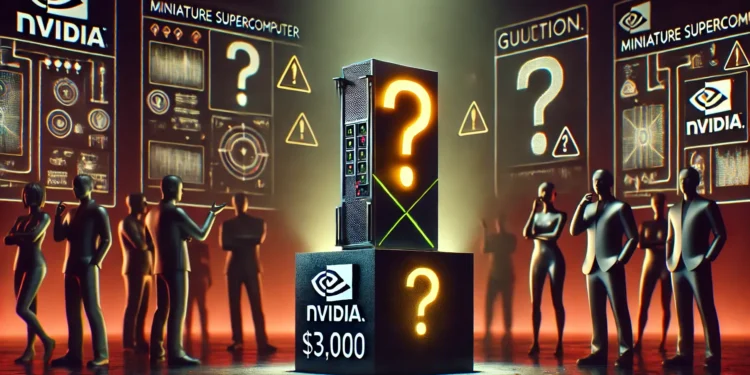NVIDIA, a global leader in the graphics processing industry, has made waves yet again with the launch of its $3,000 miniature supercomputer. Positioned as a groundbreaking device designed for artificial intelligence (AI) enthusiasts, researchers, and developers, this machine has been touted as a tool that democratizes high-performance computing. However, the launch has not been without controversy. Critics have raised concerns about the supercomputer’s real-world capabilities, with some even going as far as labeling it a “scam.”
This heated debate has divided the tech community, with questions about the device’s value, transparency, and whether its capabilities align with its hefty price tag. Let’s take a closer look at NVIDIA’s latest innovation, the allegations against it, and the broader implications for the tech industry.
NVIDIA’s Vision for a Miniature Supercomputer
The $3,000 miniature supercomputer is marketed as a compact yet powerful tool capable of revolutionizing AI research and development. It’s designed to cater to a niche audience, particularly smaller research labs, startups, and individual developers who previously lacked access to such high-level computing power.
Key features of this miniature supercomputer include:
- Compact Design: Its small, desk-friendly form factor makes it highly portable and ideal for environments with limited space.
- High Performance: The device is powered by NVIDIA’s latest GPUs, offering the same advanced graphics and processing power that the company is known for.
- Energy Efficiency: Compared to traditional, room-sized supercomputers, this device is optimized to consume far less power while still delivering impressive performance.
- Versatility: The supercomputer is equipped to handle a variety of computational tasks, including AI model training, simulations, and other intensive processes.
In theory, this combination of features makes the device a “game-changer” for anyone working on AI. Its relatively lower price point (compared to traditional supercomputers) and ease of use are aimed at expanding access to cutting-edge technology and leveling the playing field in AI development.
However, while this vision sounds promising, not everyone is convinced.
The Allegations: Is It Overhyped or Misleading?
Despite the excitement surrounding NVIDIA’s new product, critics have raised a number of issues that question whether the supercomputer can live up to its bold claims. Some have even referred to the device as a “scam,” though it’s important to note that this term is more of an exaggeration to express frustration rather than a concrete accusation of malicious intent.
Here are the primary concerns critics have voiced:
1. Overstated Capabilities
Many experts argue that the device’s advertised benchmarks and performance metrics may not reflect real-world results. While NVIDIA highlights its ability to handle complex AI tasks, skeptics claim that the hardware may struggle with certain demanding applications. This has led to disappointment among those who had high expectations for the device’s capabilities.
2. High Price Point
At $3,000, the miniature supercomputer is certainly cheaper than traditional supercomputers, but critics argue that it’s still overpriced for what it offers. For many, the device is essentially a scaled-down computing system that doesn’t justify its premium price tag, especially when compared to other hardware options available on the market.
3. Hidden Costs
Some reports suggest that users may need additional hardware or software upgrades to unlock the full potential of the device. This raises the total cost of ownership and has left some customers feeling blindsided. For example, advanced features may require separate licenses or compatibility with third-party software that isn’t included in the base package.
4. Lack of Transparency
One of the most prominent criticisms is that NVIDIA did not provide enough detailed technical specifications or independent third-party reviews before the product’s release. This lack of clarity has fueled doubts about whether the supercomputer is as revolutionary as claimed. Critics have called for more transparency, arguing that early adopters deserve to know exactly what they’re getting.
NVIDIA’s Defense
In response to the backlash, NVIDIA has stood by its product, rejecting the accusations that it’s misleading or overhyped. The company emphasizes that the miniature supercomputer is a highly specialized tool designed for a niche market, not a mass-market consumer device.
A spokesperson from NVIDIA stated:
“We stand by the quality and performance of our miniature supercomputer. It is a meticulously engineered product aimed at empowering AI developers and researchers worldwide.”
The company has also pointed out that its advertised specifications are consistent with industry standards and that the $3,000 price point reflects the cutting-edge technology inside the device. NVIDIA sees the supercomputer as an investment for those who need advanced AI computing capabilities without the costs and logistical challenges of a full-scale supercomputer.
The Tech Community Reacts
The release of NVIDIA’s miniature supercomputer has sparked a flurry of discussions across social media, tech forums, and industry events. As with any controversial product launch, the reaction has been polarized.
Positive Feedback
Supporters of the device argue that it fills an important gap in the market. Early adopters who have shared positive experiences praise the supercomputer for its efficiency, compact design, and user-friendly interface. They believe that while the device might not be perfect, it’s a step in the right direction for making high-performance AI computing more accessible.
Skepticism and Demands for Proof
On the other hand, skeptics have called for independent testing and reviews to verify NVIDIA’s claims. Some industry professionals are waiting to see how the device performs in real-world scenarios before passing judgment. Others have expressed frustration that the product feels like a rushed attempt to capitalize on the growing demand for AI tools.
Lingering Questions
The controversy has led to several key questions being raised:
- Is the device truly a cost-effective solution for AI computing, or are there better alternatives?
- How does it compare to other hardware options currently available in terms of price and performance?
- What steps can NVIDIA take to address customer concerns and rebuild trust?
The Bigger Picture: What This Means for the Industry
The debate surrounding NVIDIA’s miniature supercomputer highlights the challenges that tech companies face when launching new, high-performance products. The stakes are particularly high in a field as rapidly evolving as AI, where expectations are constantly shifting and competition is fierce.
For NVIDIA, the controversy represents a critical moment. The company must navigate the backlash carefully to protect its reputation while continuing to position itself as a leader in AI technology.
Lessons for the Tech Industry
The situation also serves as a cautionary tale for the broader tech community. Companies introducing innovative products must strike a balance between bold marketing claims and transparent communication. Overpromising and underdelivering can lead to skepticism and damage trust, even if the product itself is solid.
The Road Ahead
As the controversy unfolds, the fate of NVIDIA’s $3,000 miniature supercomputer will likely depend on two factors: independent reviews and user feedback. Early adopters will play a crucial role in determining whether the device becomes a celebrated innovation or fades into obscurity as a costly misstep.
In the meantime, the debate serves as a reminder of the importance of skepticism and due diligence when adopting new technology. For customers, the lesson is clear: always evaluate the claims of tech companies critically and seek out third-party reviews before making a purchase.
For now, whether NVIDIA’s miniature supercomputer is a true game-changer or just another overhyped gadget remains to be seen. Only time and thorough testing will tell.















